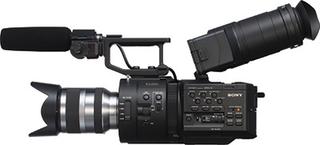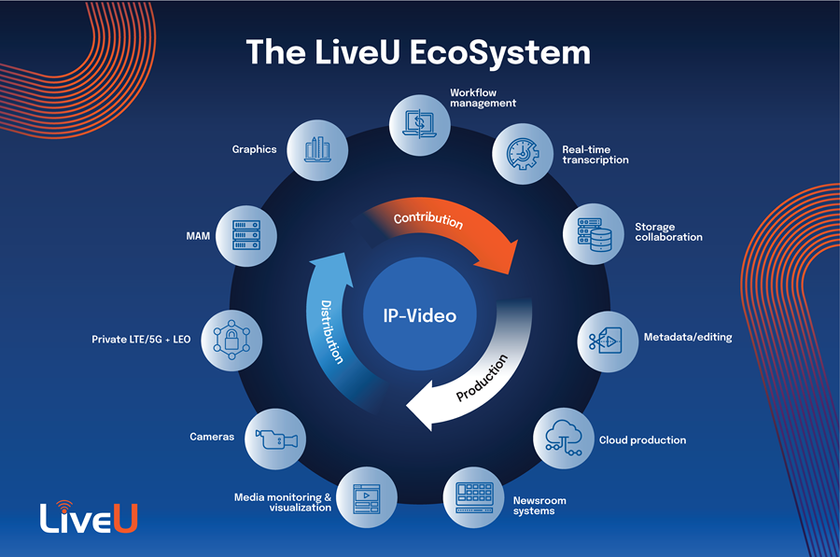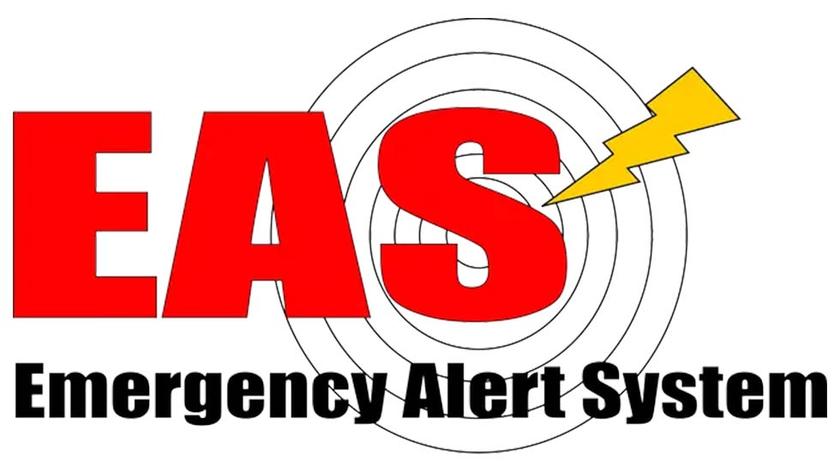Sony’s NEX-FS700 Camera

The Sony NEX-FS700 When Sony introduced its NEXFS100 camera some new ground was broken in terms of its Super 35-sized sensor, AVCHD recording codec with frame rates of up to 1080/60p at 28 Mbps, native E-mount lens system adaptable to Sony Alpha, Canon, Nikon or PL-mount lenses and, of course, its sub-$6,000 street price. But despite these innovations, I found the FS100 wanting in several respects—notably its lack of internal ND filters, SDI output, useable top handle and bottom mounting plate. With the NEX-FS700, Sony has overcome many shortcomings of the FS100 and has added features while keeping the camera in the sub-$10K price range.
FEATURES
Like the FS100, the FS700 is a rather odd-shaped camera. It feels like those medium-format cameras I used to shoot back in the days of 120 film. Sony provides any number of ways to configure the camera, however, and numerous third-party vendors offer rigs and accessories.
The modular camera has a removable top handle that bolts on securely and has front and top shoe mounts, as well as four mounting points on top. The handle is bolted so securely that it is safe to carry the camera even with a moderately heavy lens such as a PL prime. Don’t need the handle? Remove it. Don’t like it? Buy a third-party handle.
Moving to the body, there are two 1/4- 20 holes with metal sockets planted in front of the pop-up viewfinder and you’ll find even more secure mounting points on the camera bottom. Sony has clearly learned its lesson from earlier cameras with plastic mounts that led to breakage.
The right side of the camera sports a rosette to which any rosette attachment may be bolted. Sony provides a side handle for this rosette mount that has start/stop, photo and auto-iris buttons (for Sony autoiris lenses, of course). This side handle also contains a zoom rocker, which is currently nonfunctional and reserved for a future lens product. As an owner/operator of a Sony PMW-F3, I was disappointed to find that Sony has cluttered this model with yet another rocker with minimal or no use.
The FS700’s LCD display pops up from the camera’s top and can be viewed directly or through the supplied magnifying loupe—which is essentially the same loupe found on the PMW-EX3 or F3 (optional). The attachment is a little plastic-y but works effectively. However, it feels awkward viewing the image from above the camera, no matter whether the camera is handheld or mounted on a rig or tripod.
There are controls all over the unit, but they feel less cluttered than on the FS100, which again makes this camera an advance over the original design. You should definitely expect a period of adjustment while you learn where all the controls are located before you’ll be able to work most effectively.

I like the six preset buttons on the camera’s left side, which may be customized. The presets correspond to typical Sony options— zebra, peaking, histogram and marker— and two new ones, last scene and face detection.
I need to note that camera controls are not where operators of larger cameras will expect them. However, this is the way it is with many smaller cameras, not just the FS700.) White balance, for example, is on the side. I’ve come to expect white balance on the lower left front of the camera beside the lens mount. Likewise, the shutter control resides on that left side.
The FS700 is powered by Sony NP-F970 or NP-F770 batteries. The battery compartment is recessed, so it’s a bit awkward to insert the smaller battery. With optional DC input, many users will simply choose to use external V-mount or Gold-mount batteries stepped down to the appropriate voltage by third-party battery mounts.
The camera has two XLR inputs, but they are oddly located: one is below and to the right of the handle; the other is at the rear. The FS700 has HDMI and SDI outputs (the FS100 is HDMI only), as well as composite/ component outputs. A Micro USB connector links the FS700 to a computer to transfer data or update firmware. Finally, on the right side of the camera is a plate covering a slot for the optional 128 GB memory unit ($800). A LANC port allows attachment of Sony’s LANC controller unit ($1,040).
The camera ships with an external mic holder. I have been critical in the past of mic holders on most cameras in this price range. However, the FS700 offers the first holder I’ve seen that probably won’t break in the first week of use—or maybe ever, for that matter.
The FS700 records to a single SDHC, SDXC or Sony Memory Stick card. Files are saved in .mts format, which can be read by virtually every NLE. The camera records 1920 x 1080 in 60p (28 Mbps data rate), 60i, 30p and 24p. Additionally, it records in 1440 x 1080 modes, 720p, and also at SD resolutions. Like all AVCHD codec cameras, the color sample ratio is 4:2:0, with 8-bitsper- sample. In fact, internal processing of the camera is 8-bit, meaning that its SDI and HDMI output are also 8-bit.
IN USE
Sony has been touting the FS700 as 4Kready. Indeed, its Super 35 Exmor sensor has more than 11 megapixels and is capable of resolving 4K. Sony has announced 4K support for the FS-700 that’s estimated to arrive this summer. Users will need to purchase Sony’s HXR-1FR5 interface, estimated to be in the range of $1,600. The interface unit connects to the camera’s SDI port and will mate with Sony’s new AXS-R5 4K recorder ($5,350 street price). This is the same recorder which attaches directly to the new Sony F5 and F55 cameras. (In addition, Sony’s senior product manager, Juan Martinez, has stated that “current cameras will require a hardware level update,” which as of this writing, Sony has not specified.)
The second innovation, “Super Slow Motion” recording, is actually the first feature I tested. The FS700 records in Super Slow modes of 120, 240, 480 and 960 fps. Resolution of 120 and 240 fps video is a full 1920 x 1080; at 480 and 960 fps, resolution is reduced.
The camera will record specific durations of Super Slow Motion, all the way down to about 19 seconds of 960 fps. The camera buffers the recording and writes to the card when the recording stops. The documentation says it could take up to six minutes to write to the card. The faster the frame rate, the longer the write. (In one test of about 12 seconds of 960 fps video, it took close to five minutes to write to the card.)
With shutter set to match, the camera’s slow motion is remarkably strobe- and artifact- free. Clips may be played back in camera and require no conversion when imported into your NLE. As with any offspeed recording, please note that the camera cannot output overcranked footage via its SDI or HDMI ports. You must record internally.
Recording higher frame rates requires more light. While all large-sensor video and DSLR cameras demonstrate good light sensitivity, the FS700 surpasses even this high bar with the ability to boost the gain up to +30, or about 16,000 ISO. The FS700’s Exmor sensor, like that in the FS100 and F3, is amazingly noise-free. Expect some noise at 16,000 ISO, of course, but shoot at even 3,200 ISO and you’ll be amazed.
The camera ships with a native E-mount lens mount and an optional 18-200 mm f3.5- 6.3 Sony auto lens. I tested the model with the bundled lens. Sony now offers the LA-E2 adapter ($400) to adapt the camera to the full line of Sony Alpha lenses, including the Sony-Zeiss glass.
I was disappointed with the LA-E1 on the FS100 because of its lack of many automatic functions, slow response and tendency to stop down the lens completely and then set to desired aperture when changing aperture manually. All of these shortcomings are remedied with the LA-E2 adapter for the FS700. The response is fast, and the camera will auto-focus and invokes auto-iris easily. Also enabled is the built-in face recognition auto-focus function. This is a nice consumer feature, but I don’t believe it is relevant for a professional using the FS700 in a cinematic application.
Third-party adapters are available for Nikon, Canon and PL-mount lenses.
As I mentioned, one major shortcoming of the FS100 was its lack of built-in ND filters. By redesigning the front end of the camera—in fact borrowing from the F65 design—Sony was able to include a three-position ND filter on the FS700 for ND up to six stops. (Sony cameras in this range have virtually all had only two positions of ND.)
The FS700 offers four CineGammas. These may be invoked in user-created picture profiles. While I’m mentioning picture profiles, a number of users have created profiles (easily downloadable) and Abel- Cine has a whole set available free on its Website.
Sony still has not addressed a shortcoming I see on all of its cameras in this price range: the only level indicating “scope” included with the camera is a histogram. I personally find a waveform monitor much more useful and wish Sony would consider adding it.
SUMMARY
The FS700 is a worthy addition to Sony’s NXCAM lineup, as well as to its Super 35 sensor strategy. I tend to resist comparisons, but I think it’s important to note that the FS700 isn’t exactly a baby F3; it is an 8-bit camera without much of the image post-processing of the F3. It lacks a log gamma curve. Note, however, that AbelCine’s picture profiles contain a log emulation profile. However, as the FS700’s sensor is the same as that in the F3, picture profiles can be used to match cameras, the FS700 and F3 cut very well together. I would not hesitate to use an FS700 as a B-cam to my F3, particularly if I needed super-slow-motion footage.
What is the target market of the FS700? I find far too many shooters attempting to use large-sensor cameras for run-and-gun applications, not realizing that the shallow depth of field of Super 35 cameras makes this a difficult proposition. Outfitted with the appropriate automatic Sony E or Sony Alpha lenses, the FS700 is a suitable run-and-gun camera, though I wouldn’t try it without a third-party rig—it’s just too awkward to handhold the FS700 (even with the rosette- attached grip) for longer than a few minutes.
It’s in independent film and documentary production that the FS700 shines. This camera is compact and affordable, delivering a sharp image with tremendous versatility. Between offerings from Sony and third-party vendors, it can be configured in an almost unlimited number of ways.
I recommend it strongly.
Ned Soltz is an independent shooter, editor and producer as well as consultant and general technology guru. With more than 30 years experience, he learned to shoot on a “Sony portapack” and edit reel-to- reel tape. In addition to current production and consulting projects, he is a contributing editor for Digital Video magazine.
FAST FACTS
APPLICATION
Production of documentary and feature footage
KEY FEATURES
4K-ready Super 35 sensor, super-slow-motion frame rates, recording up to 1080/60p, three-position ND, secure mounting points, modular design
PRICE
$9,900 MSRP with 18-200 mm E-mount lens; $9,200 without lens
CONTACT
Sony Electronics
201-930-1000
http://pro.sony.com
Get the TV Tech Newsletter
The professional video industry's #1 source for news, trends and product and tech information. Sign up below.













